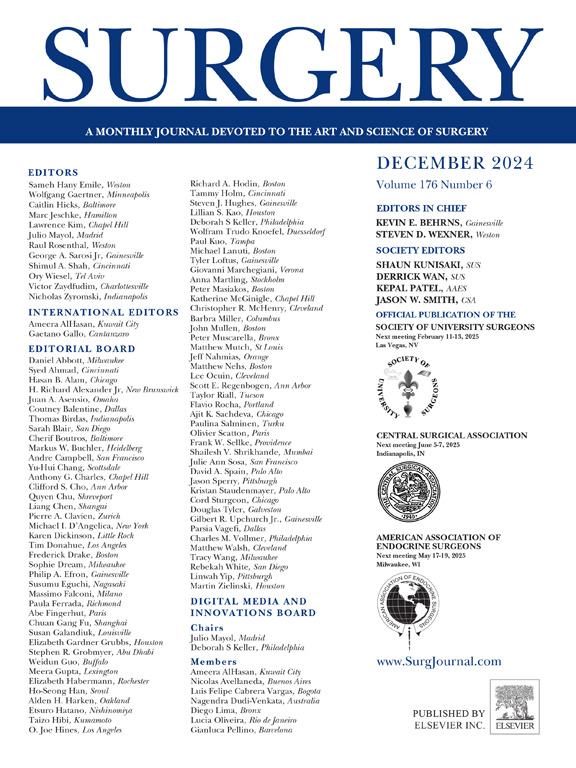胰十二指肠切除术后一天血清胰淀粉酶对术后胰瘘动态风险分层的影响
IF 2.7
2区 医学
Q1 SURGERY
引用次数: 0
摘要
各种生物标志物的适当组合,包括血清胰淀粉酶、引流淀粉酶和c反应蛋白水平,对于评估胰十二指肠切除术后患者状态的动态变化至关重要。本研究旨在利用术后1 ~ 3天的临床适用参数,建立与临床相关的术后胰瘘的动态风险分层。方法对234例胰十二指肠切除术患者的资料进行分析。使用术后第1至3天可用的生物标志物进行多变量分析。结果术后胰瘘56例(24%),术后C级胰瘘12例(5%),胰切除术后出血24例(10%)。尽管引流淀粉酶和c反应蛋白的预后价值随着时间的推移而提高,但术后第1天和第2天的血清胰淀粉酶水平同样可以预测临床相关的术后胰瘘。血清胰淀粉酶水平高的患者患瘘风险评分明显较高。多因素分析显示,术后第1天血清胰淀粉酶≥75 U/L和引流淀粉酶≥2000 U/L是独立危险因素(优势比分别为18.0和3.45)。术后第2天加入c反应蛋白,术后第1天分层可提高诊断准确率(优势比:3.19)。最后,在术后第3天进行风险评估,术后第1天使用血清胰淀粉酶≥75 U/L,术后第3天使用引流淀粉酶≥5000 U/L,术后第3天使用c反应蛋白≥22 mg/L,识别出75%的具有临床相关性的术后胰瘘最高风险的患者(优势比分别为19.7、5.41和5.01),准确率为87%。结论术后第1天使用血清胰淀粉酶进行动态风险分层,术后第1 ~ 3天识别高危患者的准确率逐渐提高。使用合适的生物标志物,包括围手术期的生物标志物,可以促进高危患者的早期识别。本文章由计算机程序翻译,如有差异,请以英文原文为准。

Impact of dynamic risk stratification for postoperative pancreatic fistula using serum pancreatic amylase on the day after pancreatoduodenectomy
Background
An appropriate combination of various biomarkers, including serum pancreatic amylase, drain amylase, and C-reactive protein levels, is pivotal for assessing the dynamic changes in patient status after pancreatoduodenectomy. This study aimed to establish a dynamic risk stratification for clinically relevant postoperative pancreatic fistula using clinically applicable parameters on postoperative days 1 to 3.
Methods
Data from 234 patients who underwent pancreatoduodenectomy were analyzed. Multivariate analyses were conducted using biomarkers available on postoperative days 1 to 3.
Results
Clinically relevant postoperative pancreatic fistula, grade C postoperative pancreatic fistula, and postpancreatectomy hemorrhage were observed in 56 (24%), 12 (5%), and 24 (10%) patients, respectively. Although the prognostic value of drain amylase and C-reactive protein improved over time, serum pancreatic amylase levels on postoperative days 1 and 2 were equally predictive of clinically relevant postoperative pancreatic fistula. Patients with high levels of serum pancreatic amylase had significantly high fistula risk scores. Multivariate analysis revealed that serum pancreatic amylase ≥75 U/L and drain amylase ≥2,000 U/L on postoperative day 1 were independent risk factors (odds ratio: 18.0 and 3.45, respectively). Adding C-reactive protein on postoperative day 2 to the stratification on postoperative day 1 improved the diagnostic accuracy (odds ratio: 3.19). Finally, risk assessment on postoperative day 3, using serum pancreatic amylase ≥75 U/L on postoperative day 1, drain amylase ≥5,000 U/L on postoperative day 3, and C-reactive protein ≥22 mg/L on postoperative day 3, identified 75% of patients at highest risk for clinically relevant postoperative pancreatic fistula (odds ratio: 19.7, 5.41, and 5.01, respectively), with an accuracy of 87%.
Conclusions
Dynamic risk stratification using serum pancreatic amylase on postoperative day 1 gradually increased the accuracy of identifying high-risk patients from postoperative days 1 to 3. Using suitable biomarkers, including those at each perioperative stage, can facilitate the early identification of high-risk patients.
求助全文
通过发布文献求助,成功后即可免费获取论文全文。
去求助
来源期刊

Surgery
医学-外科
CiteScore
5.40
自引率
5.30%
发文量
687
审稿时长
64 days
期刊介绍:
For 66 years, Surgery has published practical, authoritative information about procedures, clinical advances, and major trends shaping general surgery. Each issue features original scientific contributions and clinical reports. Peer-reviewed articles cover topics in oncology, trauma, gastrointestinal, vascular, and transplantation surgery. The journal also publishes papers from the meetings of its sponsoring societies, the Society of University Surgeons, the Central Surgical Association, and the American Association of Endocrine Surgeons.
 求助内容:
求助内容: 应助结果提醒方式:
应助结果提醒方式:


